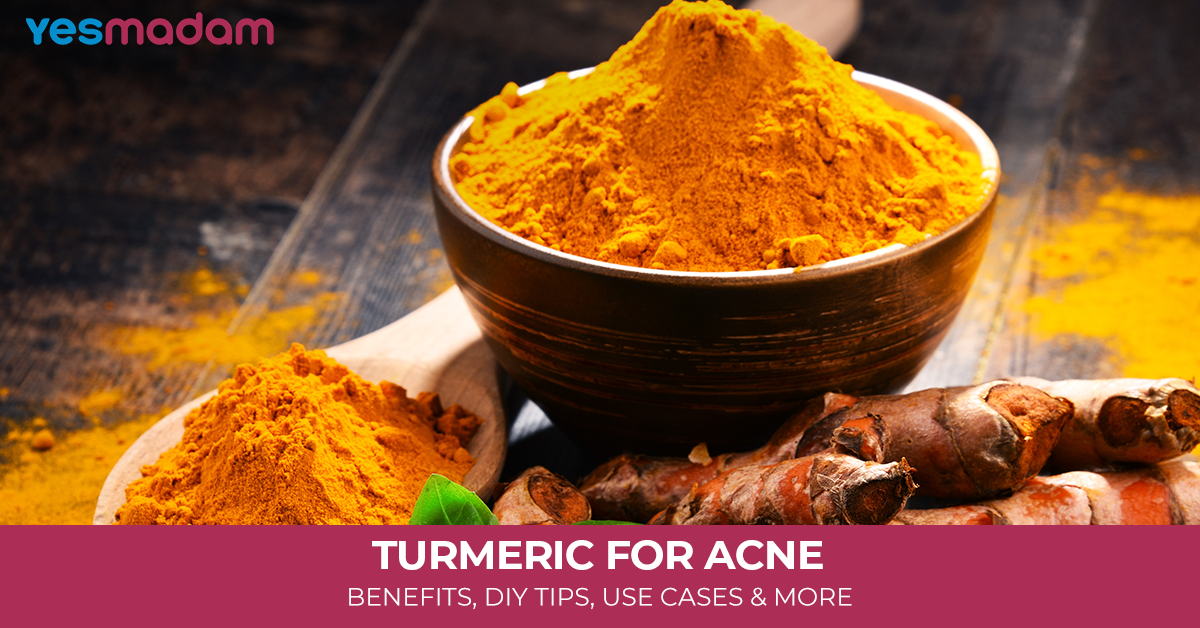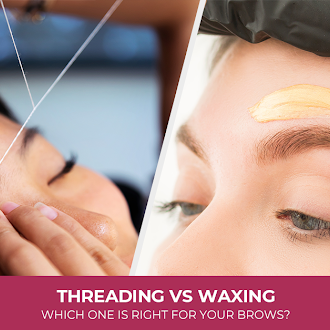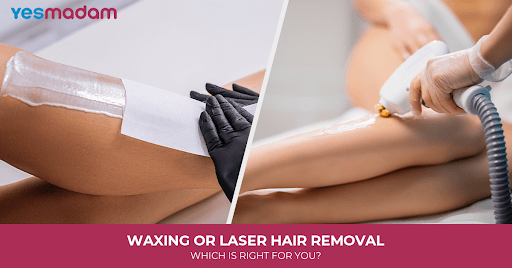
Turmeric for Acne: Benefits, DIY Tips, Use Cases and More
Acne is a common skin-related problem that most of us have experienced or are still experiencing. The worst part? Scars that don’t fade easily, making the situation even more frustrating. If this sounds familiar, it’s time to try a simple, kitchen-based solution for acne-prone skin.
Turmeric, the bright yellow spice, is valued for its anti-inflammatory and antibacterial effects, making it the perfect home remedy for acne-prone skin. This guide explains how using turmeric for acne can help reduce breakouts and naturally enhance your skin’s texture.
More Information For You: Honey for Acne

Table of Contents
What is Turmeric?
Turmeric comes from the curcuma longa plant and has been used in traditional medicine for centuries. Its main compound, curcumin, gives it the bright yellow color and most of its healing power.
While it’s a common spice in Indian and middle eastern cooking, it’s also gaining popularity in supplements and skincare. Its anti-inflammatory and antibacterial properties make it a simple yet powerful remedy to support your skin and overall health.
Is Turmeric Good for Acne?
Yes, turmeric can help acne-prone skin due to its prime compound called curcumin. Its anti-inflammatory and antibacterial properties reduce redness and fight acne-causing bacteria.
It also helps fade acne scars, smooth skin texture, and protect against free radicals that lead to aging and damage.
Benefits of Traumatic for Acne
Turmeric treats various skin concerns. It’s easy to use, and packed with benefits that can improve your skin’s health and appearance.
Here’s a deeper look into how turmeric can help your face:
Anti-inflammatory and antioxidant properties
Turmeric has curcumin, which helps reduce inflammation and fight free radicals, making it perfect for calming irritated or sensitive skin. It fights bacteria, reduces swelling, and helps prevent future breakouts. It also protects your skin from pollution and sunlight, which can help slow signs of aging.
Brightening and glowing skin
When used regularly, turmeric can help your skin look brighter and more radiant. It improves skin tone by boosting circulation and reducing dullness. Its natural glow-enhancing properties can make your face look healthier and more refreshed.
Reduces hyperpigmentation and dark spots
Turmeric helps to control melanin, the pigment that causes dark spots and uneven skin tone. With consistent use, it can lighten areas of discoloration and improve your skin’s overall clarity, especially in cases of sun damage or acne scars.
Fights acne and pimples
With antibacterial and anti-inflammatory abilities, turmeric can help treat active pimples, reduce swelling, and keep pores clean. It may also prevent future breakouts by fighting acne-causing bacteria and reducing oiliness.
Heals wounds and scars
Turmeric speeds up the skin’s healing process by boosting tissue growth. Whether it’s small cuts or acne scars, it helps repair the skin and can make old scars less visible over time by promoting smoother, clearer skin.
Moisturizes and hydrates dry skin
Turmeric helps restore moisture to dry and flaky skin. It supports the skin’s natural barrier and prevents water loss, keeping the skin soft, smooth, and nourished, especially in harsh or dry weather.
Reduces dark circles
By improving blood flow and reducing inflammation, turmeric can help fade dark under-eye circles and lessen puffiness. It works gently around the eyes to make them look brighter and more awake.
May help with facial hair
Turmeric has been traditionally used to slow down the growth of fine facial hair. While results can take time, regular application may help reduce the thickness and visibility of hair on the face.
Gentle exfoliation
Turmeric acts as a mild exfoliant. It removes dead skin cells without irritating the skin. This makes your skin feel smoother and look fresher, with better texture and tone over time.

How to use turmeric for pimples
Apply it directly:
Make a simple paste using turmeric powder with either water or honey and dab it on pimples or breakout-prone areas.
Add it to masks:
Mix turmeric with ingredients like yogurt, lemon juice, or honey to create face masks for clearer skin.
Drink turmeric milk:
Consuming warm milk with turmeric can help reduce inflammation and fight bacteria from within.
Use turmeric oil:
Applying turmeric-infused oil may help fade blemishes and keep breakouts under control.
Things to keep in mind:
- Skin reactions: Test on a small patch by applying on a small skin portion first, as some people may be sensitive to turmeric.
- Staining: Turmeric may leave yellow stains on skin or fabric, so apply with care.
- Get advice if needed: For serious acne or concerns, talk to a dermatologist before trying turmeric.
How To Use Turmeric for Acne: DIY Home Remedies
If you’re dealing with acne or scarring, incorporating turmeric into your skincare routine can bring noticeable improvements.
Here are some simple yet effective face masks to help you fight acne and fade scars naturally.
1. turmeric and honey mask
Honey has natural antibacterial properties that fight acne-causing bacteria, while turmeric helps reduce redness and inflammation, making them perfect for soothing irritated skin.
How to use:
- Combine 1 teaspoon of turmeric powder with 1 tablespoon of honey.
- Mix until a smooth paste forms.
- Apply the paste to your face, concentrating on acne-prone areas.
- Let it sit for 10–15 minutes to let the ingredients work.
- Rinse off with warm water.
This mask not only helps reduce acne but also provides hydration, which is essential when dealing with inflamed skin.
2. Turmeric and yogurt mask
Yogurt contains lactic acid, which gently exfoliates your skin and helps clear clogged pores, a common cause of acne. Combined with turmeric’s anti-inflammatory properties, it makes a great mask to prevent future breakouts.
How to use:
- Mix 1 teaspoon of turmeric with 2 tablespoons of plain yogurt.
- Stir to form a thick paste.
- Apply it evenly on your face and let it sit for 10–15 minutes.
- Wash off with warm water.
This mask helps exfoliate the skin while keeping it soft and moisturized, preventing excess dryness often caused by acne treatments.
3. Turmeric and aloe vera mask
Aloe vera is widely known for its soothing and healing properties which makes it perfect for calming irritated skin. When combined with turmeric, it not only helps fight acne but also prevents new breakouts from forming.
How to use:
- Mix 1 teaspoon of turmeric with 2 tablespoons of aloe vera gel.
- Apply the paste evenly over your face, focusing on the acne-affected areas.
- Let it sit for 10–15 minutes.
- Rinse with warm water.
This mask is great for sensitive skin types since aloe vera helps reduce redness and inflammation without being harsh.
4. Turmeric and sandalwood mask
Sandalwood has natural antibacterial and cooling properties that work well with turmeric’s anti-inflammatory benefits. Together, they help prevent acne and calm irritated skin, leaving it feeling refreshed and rejuvenated.
How to use:
- Mix turmeric powder and sandalwood powder in equal parts.
- Slowly add milk to form a thick, smooth paste.
- Apply it evenly to your face, avoiding the eyes.
- Leave it on for 15–20 minutes until it dries completely.
- Rinse off with warm water.
The milk helps soften and hydrate the skin, adding an extra boost of moisture, making this mask ideal for dry skin types.
5. Turmeric and lemon mask
Lemon has natural brightening properties and is rich in vitamin C, which helps fade dark spots left behind by acne. Turmeric balances out the skin by reducing inflammation and preventing future breakouts.
How to use:
- Mix turmeric powder, freshly squeezed lemon juice, and honey in a small bowl.
- Apply the paste to your face, avoiding the eye area.
- Leave it on for 10–15 minutes.
- Wash off with warm water.
This turmeric for acne scars brightens scar marks and reduces inflammation. However, be cautious if you have sensitive skin, as lemon can be a bit strong.
6. Turmeric and neem mask
Neem is known for its antibacterial properties which make it a strong ally in fighting acne. It also helps purify the skin, while turmeric enhances its anti-inflammatory and healing benefits.
How to use:
- Blend fresh neem leaves with a little water to form a paste.
- Add 1 teaspoon of turmeric powder to the neem paste and mix thoroughly.
- Apply the mask to your face, avoiding the eyes.
- Let it sit for 15–20 minutes before rinsing off with warm water.
Neem and turmeric together are perfect for treating acne and reducing the appearance of acne scars.
7. Turmeric and cinnamon mask
Cinnamon has antifungal and antimicrobial properties, which help combat acne-causing bacteria. Rose water, known for its anti-inflammatory benefits, works with turmeric to reduce redness and swelling associated with acne.
How to use:
- Mix 1 teaspoon of turmeric powder with 1 teaspoon of cinnamon powder and a few drops of rose water.
- Apply the paste to your face, avoiding the eye area.
- Leave it on for 10–15 minutes.
- Wash off with warm water.
This mask is ideal for those with oily or acne-prone skin, as it helps control bacteria and inflammation effectively.
8. Turmeric and apple cider vinegar mask
Apple cider vinegar helps exfoliate the skin and balance its pH, which is crucial for preventing acne. It also has antibacterial properties that inhibit acne-causing bacteria, while turmeric provides its soothing benefits.
How to use:
- Mix 1 teaspoon of apple cider vinegar with 1 teaspoon of water.
- Add ½ teaspoon of turmeric powder and stir until smooth.
- Apply the mask to your face by avoiding the eyes.
- Let it dry and rinse with warm water.
- This mask helps keep your skin’s pH in check, which is vital for maintaining clear skin.

Does and Don’t While using Turmeric for Acne
Before adding turmeric powder to your skincare routine for acne and better results, consider these dos and don’ts for maximizing its benefits:
| Dos | Don’ts |
| Do a patch test before applying to face | Don’t use too much turmeric (it can stain skin) |
| Use pure, organic turmeric | Don’t mix with harsh ingredients like lemon |
| Mix with soothing bases (yogurt, honey) | Don’t apply on open wounds or popped pimples |
| Apply as a thin, even layer | Don’t leave on for too long (10–15 mins is enough) |
| Rinse off with lukewarm water | Don’t expect instant results |
| Moisturize after use | Don’t use daily—2–3 times a week is enough |
Recommended You: Home Treatments for All Types of Acne
Conclusion
Turmeric for acne is a natural, affordable, and effective remedy that can help reduce inflammation, kill acne-causing bacteria, and fade stubborn scars. Whether applied as a face mask or taken internally, this golden spice promotes clearer, healthier skin without harsh chemicals.
With consistent use and the right precautions, turmeric can become a right choice for your skincare routine. If you’re looking for a holistic solution to acne, turmeric offers time-tested benefits backed by both tradition and science.
FAQs
Can turmeric reduce acne?
Yes, turmeric has anti-inflammatory and antibacterial properties that may help calm acne and prevent breakouts.
How to make turmeric face pack for acne?
Mix 1 tsp turmeric powder with 1 tbsp honey or yogurt to form a paste. Apply to clean skin, leave for 10–15 minutes, then rinse with warm water. Use 2–3 times a week.
Can turmeric remove acne scars?
Yes, turmeric can help fade acne scars over time because it reduces inflammation and may lighten dark spots. However, it works best on mild scars and results vary its not a guaranteed cure for deep or old scars.
How to use turmeric on face for acne scar?
Mix turmeric powder with honey or yogurt to make a paste, then apply it to acne scars. Leave it on for 10–15 minutes, then rinse off with warm water.
How should turmeric be used for acne?
You can apply it as a face mask mixed with honey or yogurt, or take it as a supplement after consulting a doctor.
Is turmeric safe for sensitive skin?
It can be safe, but do a patch test first. Some people may react to turmeric or other ingredients in DIY masks.
How often can I apply turmeric on my face?
1–3 times a week is enough to avoid staining or irritation.
Does turmeric cause yellow staining on skin?
Yes, turmeric can temporarily stain the skin yellow, especially if used in large amounts.
Which type of turmeric is best for acne?
Organic or wild turmeric (kasturi manjal) is preferred for skin use as it’s less likely to stain and irritate.
How long does it take for turmeric to show results?
Some may see improvement in a few weeks, but consistent use over time works best.
Are there any side effects of using turmeric on skin?
Possible side effects include dryness, irritation, or staining. Always do a patch test first.



